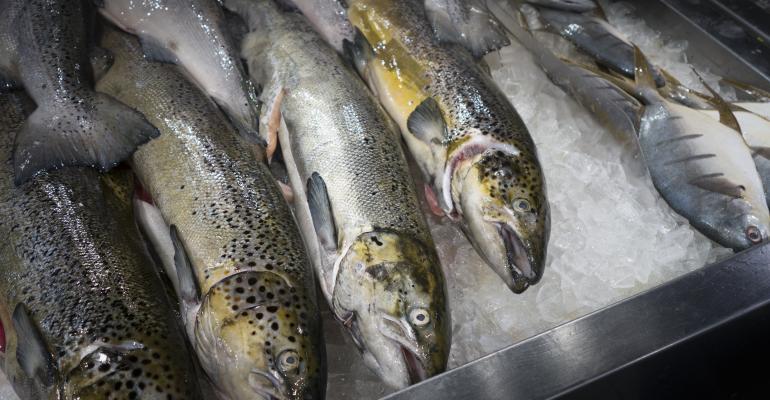You already have an impactful product marketing vehicle right under your nose.
And it’s the supermarket seafood department display case.
“The seafood display case can have a significant impact on seafood department sales,” said Chuck Anderson, vice president and partner with Certified Quality Foods, a Dallas-based analyzer of seafood quality, and the former vice president of seafood procurement for Quincy, Mass.-based Ahold USA, and the former category manager for seafood at San Antonio-based H-E-B. “A well-merchandised case sells product, and seafood shoppers buy with their eyes.”
How do you do that? Start by triggering shoppers’ tendencies toward impulse purchases, which Anderson said begins with an eye-catching display.
“Fresh seafood has so many great colors and textures to merchandise, and the right case also protects seafood while enticing the customer to take a closer look,” he said.
Choose a case that maintains product temperature and moisture while spotlighting seafood’s vibrant colors and textures, Anderson said. “The first consideration is always product quality,” he said. “The second is how the case highlights and merchandises selections.”
Seafood cases also must be large enough to attractively display a wide range of selections, without having the excessive space which often entices retailers to situate products that go unsold, resulting in shrink.
“The case must be the proper size for a seafood department’s sales volumes,” he said. That includes having the appropriate capacity for spotlighting products during high-traffic weekends when more seafood inventory is in the case, as well as for lower-volume weekdays, Anderson said.
In addition, designs should enable department associates to both easily situate products and access all the inner areas for proper washing and sanitizing, he said. “The seafood case interior surfaces must be food grade and non-porous,” Anderson said, adding that the stainless-steel design also should be high grade. “Saltwater draining from fish can cause corrosion in lower grades,” he said. “Poor sanitation of cases is one of the leading causes of fishy odors in the seafood department.”
Another key consideration is whether to leverage open- or closed-air cases. It’s typically simpler to arrange seafood in open-air designs and to keep the cabinet and products clean and orderly, Anderson said, which results in a more visually appealing appearance. Open-air displays also can better support the merchandising of seafood on ice, which conveys a stronger image of freshness, he said.
Yet, open-air designs frequently require more cleaning and retailers are more apt to overload the case with product, which can cause the surface temperatures of the seafood to exceed 40 degrees and result in dryer fish with a shorter shelf life.
Closed-air refrigerated cases can offer more precise temperature control, which will enable fresh products, such as fish fillets, to stay cold and moist longer, he said. The closed design also better protects products from dust and insects and is available in a wider variety of layouts while creating a more upscale, polished impression, Anderson said.
Regardless of the design, all case displays should result in a dramatic product appearance, he said.
“Alternating colors and textures make seafood stand out and are attractive to customers,” Anderson said. “Large displays of high-volume products, such as salmon and shrimp, and popular impulse items, including crab and lobster tails, drive sales when aggressively and attractively merchandised in the case.”
Lighting should be cool or natural white to mimic daylight and be bright enough to illuminate fish without creating excess heat or shadows. Anderson added, however, that retailers should avoid lighting that highlights any single color, and particularly red.
“Lighting with lots of red spectrum will make salmon and tuna look great but will make white fish appear unnatural and off color,” he said.
Retailers can further enhance interest and better showcase seafood by ensuring that the signage within the case, including product descriptors and price tags, does not conceal the seafood, Anderson said. Angling fish toward the customer also can add intrigue, he said.
The use of specific designs also will often vary in accordance with the products being merchandised, Anderson said. That includes the use of typically smaller self-service case for such items as seafood soups, salads, dips, smoked fish, and ready-to-eat grab-and-go products.
Operators must remember, however, that “the product should always be the star of the display,” he said, and that such elements as ice and signage should be secondary “and almost go unnoticed.”





